5 Nature Reserves to Embark on a Wildlife Spotting Adventure
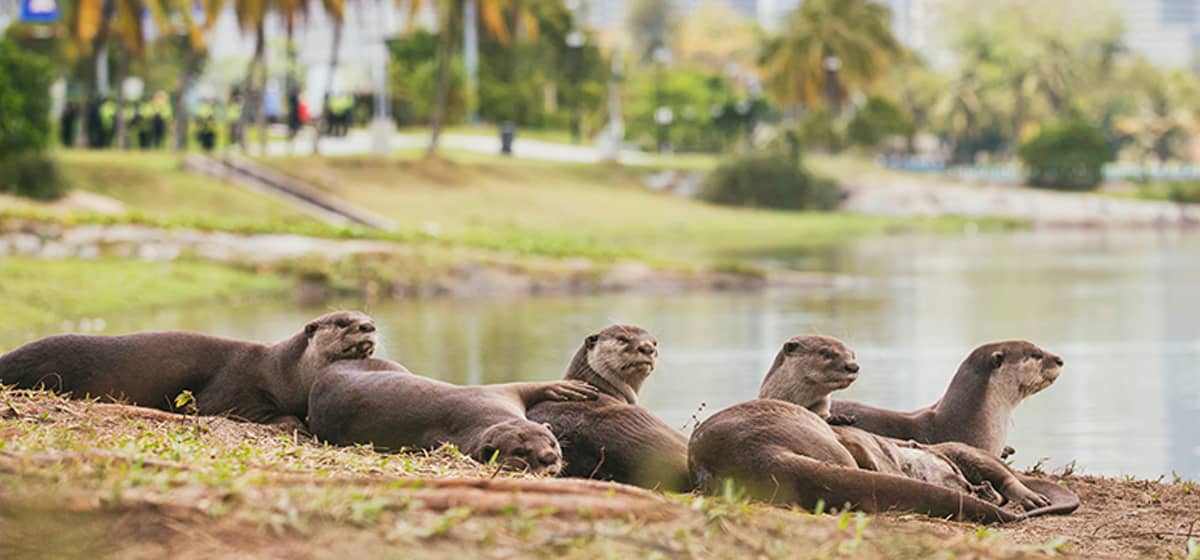
Living in a concrete jungle like Singapore, it may be easy to forget that we share our island with over 40,000 species1 of flora and fauna. These include native blooms such as the Wild Rose Apple and Akar Kepapal, which we’ve featured in our Chinese New Year Red Packets this year in collaboration with the National Parks Board (NParks)’s Garden City Fund, as well as a diversity of animals like owls, crocodiles and of course – our favourite families of otters.
This comes as no surprise since our sunny island used to be a rich and dense tropical jungle. While Singapore has rapidly urbanised since its early days, wild animals can still be spotted today at pockets of nature around our country given continuous conservation efforts.
If you’re up to spot some elusive animals living within our midst, grab your hiking boots for a trip to the wild right here in Singapore! Explore the many green spaces on our little red dot and get ready to be fascinated by the myriad of species that call Singapore home. At the same time, do keep a look out for the many native flowers that we’ve mentioned in our previous blogpost here. These wildlife add to the dynamism of our urban city, and truly makes Singapore unique.
Without further ado, here’s introducing five animals native to Singapore that can’t be missed:
1. Estuarine Crocodile at Sungei Buloh Wetland Reserve
Naturally found in our local wild, with its first sightings in Singapore tracing back to the 1800s2, the Estuarine Crocodile, also known as Saltwater Crocodile, is one of the largest crocodile species in the world and can grow to more than five metres in length3. This majestic creature often camouflages itself by keeping partially submerged in water, with only its eyes, nostrils, and part of its back exposed4, and can be found in coastal areas and wetlands such as our Sungei Buloh Wetland Reserve5.
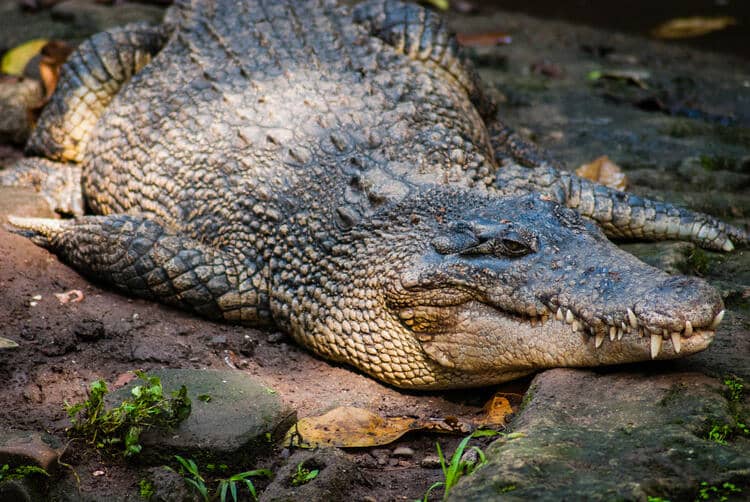
Fun fact: The Estuarine Crocodile has the most powerful bite out of all species of crocodiles, earning them the reputation as a top apex predator4!
Sadly, the Estuarine Crocodile is classified as critically endangered3 both internationally and in Singapore due to the destruction of its habitats, as well as overhunting for its hide to make products such as shoes and handbags. Overseas, its hatchlings are also sometimes sold as pets.
Besides keeping an eye out for these crocodiles, do look out for the wide range of native flora that Sungei Buloh is also home to. These include the bright yellow Sea Hibiscus6 and sweet scented Penaga Laut</strong class=”f-blue”>7 flowers, the latter of which is often used as dye, oil and even medicine. In addition, many native species such as the Mangrove Horseshoe Crab8 and Giant Mudskipper8 are also residents of Sungei Buloh. What’s more, the wetland also counts reptiles such as the King Cobra8 and Malayan Water Monitor8 as part of its dynamic ecosystem.
2. Sunda Pangolin at Bukit Timah Nature Reserve
The Sunda Pangolin, is a scaly mammal that is native to Singapore and the larger Southeast Asian region9. A unique animal unlike any other, the pangolin is covered with brown scales and has long claws as feet10. Found at various areas of Singapore, including Bukit Timah Nature Reserve9, this shy and solitary animal hunts mainly at night and feeds on insects such as ants and termites. For adult pangolins, it can consume up to 70 million insects every year9!
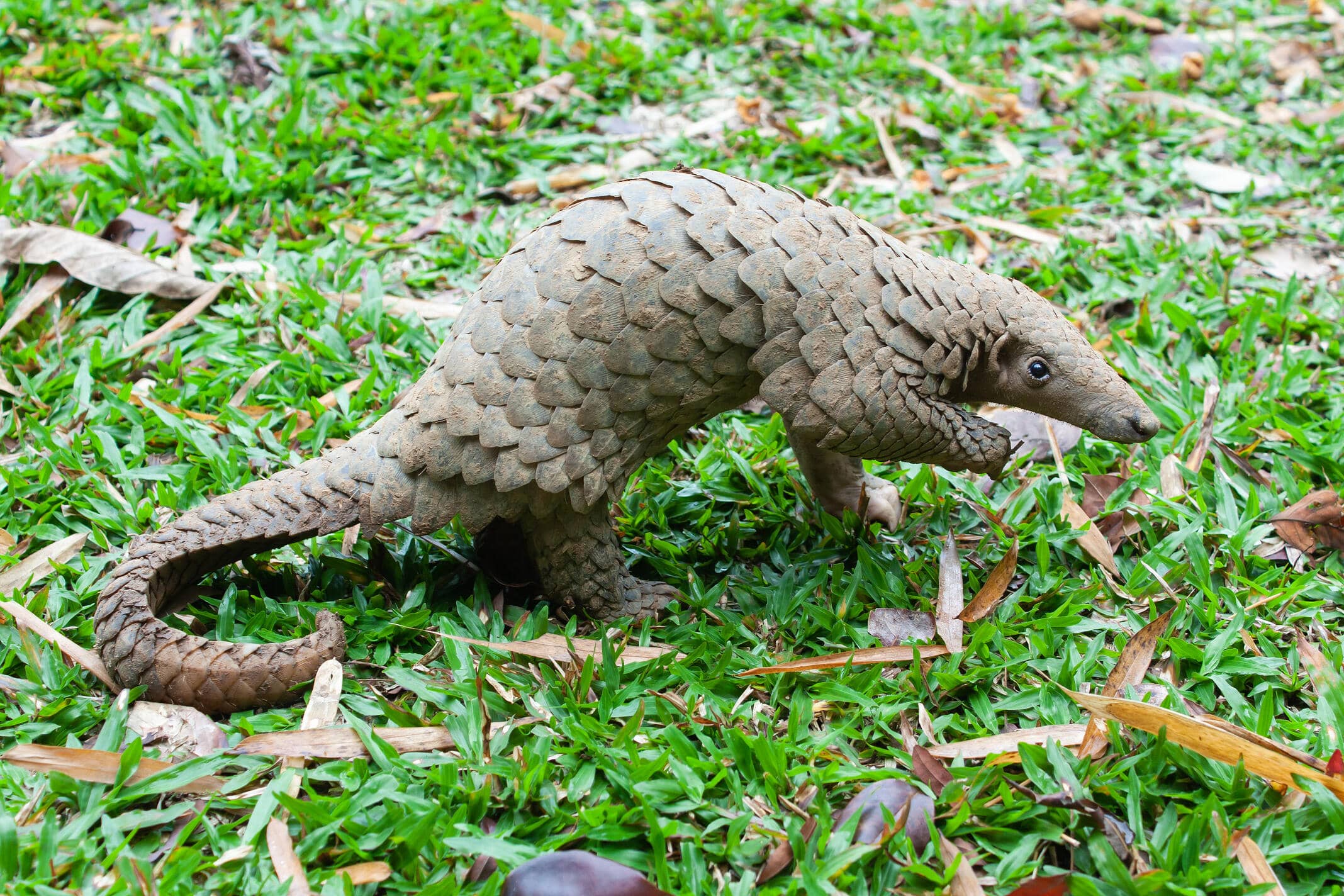
Fun fact: Its tough scales are actually made of compressed hair9! When threatened, the pangolin curls itself up into an armoured ball by wrapping its tail around its body to protect its non-scaly underparts, and may even use its anal gland to produce a foul smell to deter predators9.
Similar to the Estuarine Crocodile, the Sunda Pangolin is listed as critically endangered9 in Singapore due to the mass urbanisation that resulted in widespread habitat loss. Internationally, the low population of these animals can be attributed to over poaching for its meat and scales9. This is further exacerbated by its low fertility rate, resulting in its global population depleting much faster than it can recover9.
Given its elusive nature, it’s your lucky day should you come across a pangolin when visiting Bukit Timah Nature Park! However, fret not should you not be able to spot one as the park is also home to a wide range of other native plants. This includes the Seraya11 that is one of the oldest trees in Singapore, estimated to be at least 150 years old12!
3. Common Palm Civet at Bukit Batok Nature Park
Known affectionately as the Toddy Cat13, the Common Palm Civet is a nocturnal native mammal found in areas such as Bukit Batok Nature Park13. An omnivore, the civet can often be spotted navigating from tree to tree and feeding on fruits, leaves and worms13.
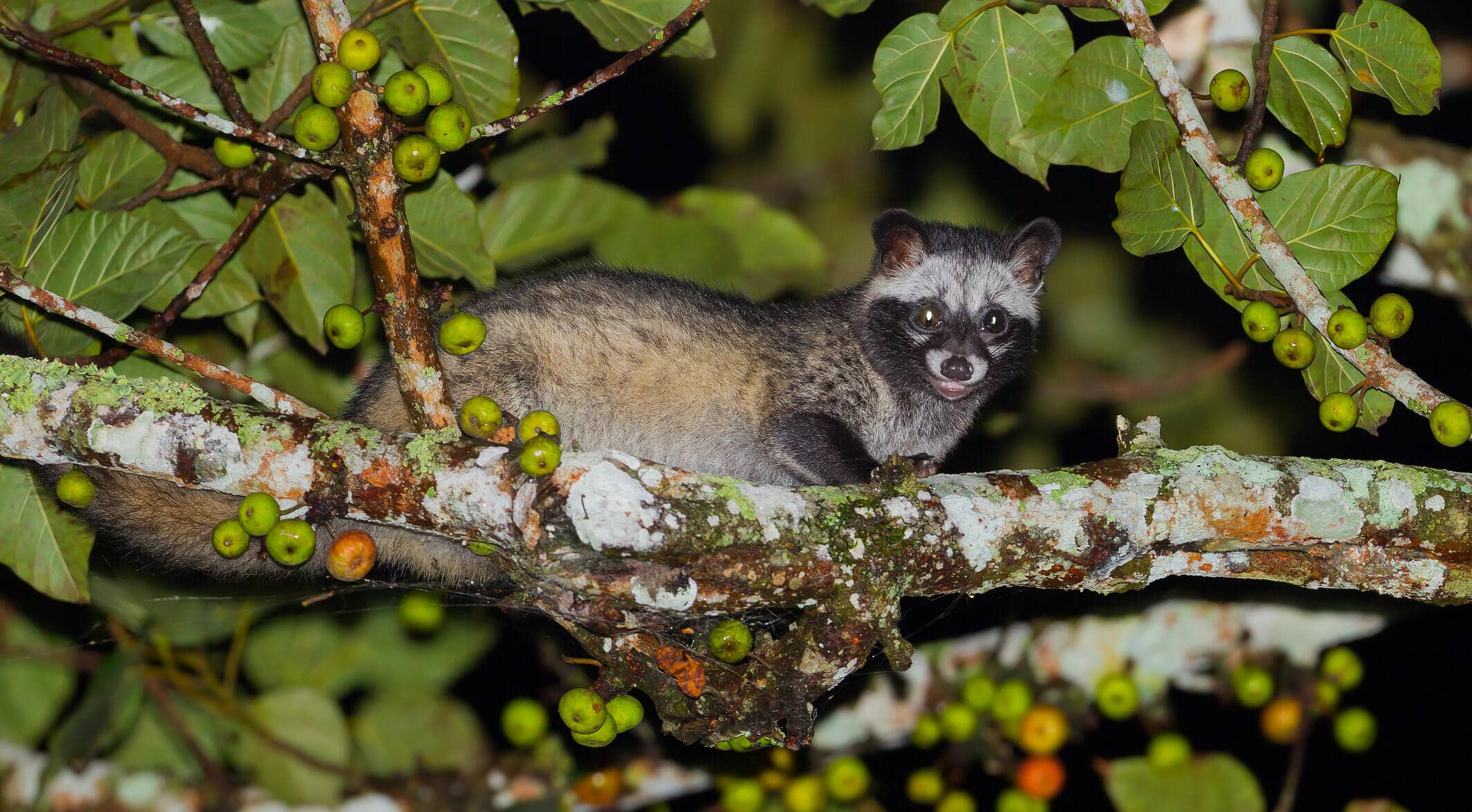
Fun fact: The length of its tail is almost of equal length as its entire body14!
Like other members of the civet family, the Common Palm Civet has a pair of stink glands near the base of its tail, which secretes a foul-smelling liquid when it feels threatened15. Interestingly, however, some have described these secretions as smelling like pandan16!
If you’re a coffee lover, you may have also heard of civet-processed coffee, otherwise known as Kopi Luwak. However, due to increasing global demand for this type of coffee, it has given rise to unethical production practices17, often involving the poor treatment of these civets. Hence, should you come across Kopi Luwak, we’d encourage you to be mindful and say no to such coffee choices!
Besides keeping an eye out for these civets at Bukit Batok Nature Reserve, do also look out for the leafy Tembusu18 trees that are native to Singapore. These large trees can grow up to 25 metres18 in height and is one of the many heritage trees identified in Singapore.
4. Wild Boar at Pasir Ris Nature Park
Native to Singapore, wild boars are large pigs that can weigh up to 100kg19. While they are natural omnivores19, these animals feed mainly on a plant-based diet that includes seeds, tubers and young plants19. With a keen sense of smell, these wild boars are foraging animals and are able to dig out underground tubers and seed for food20.
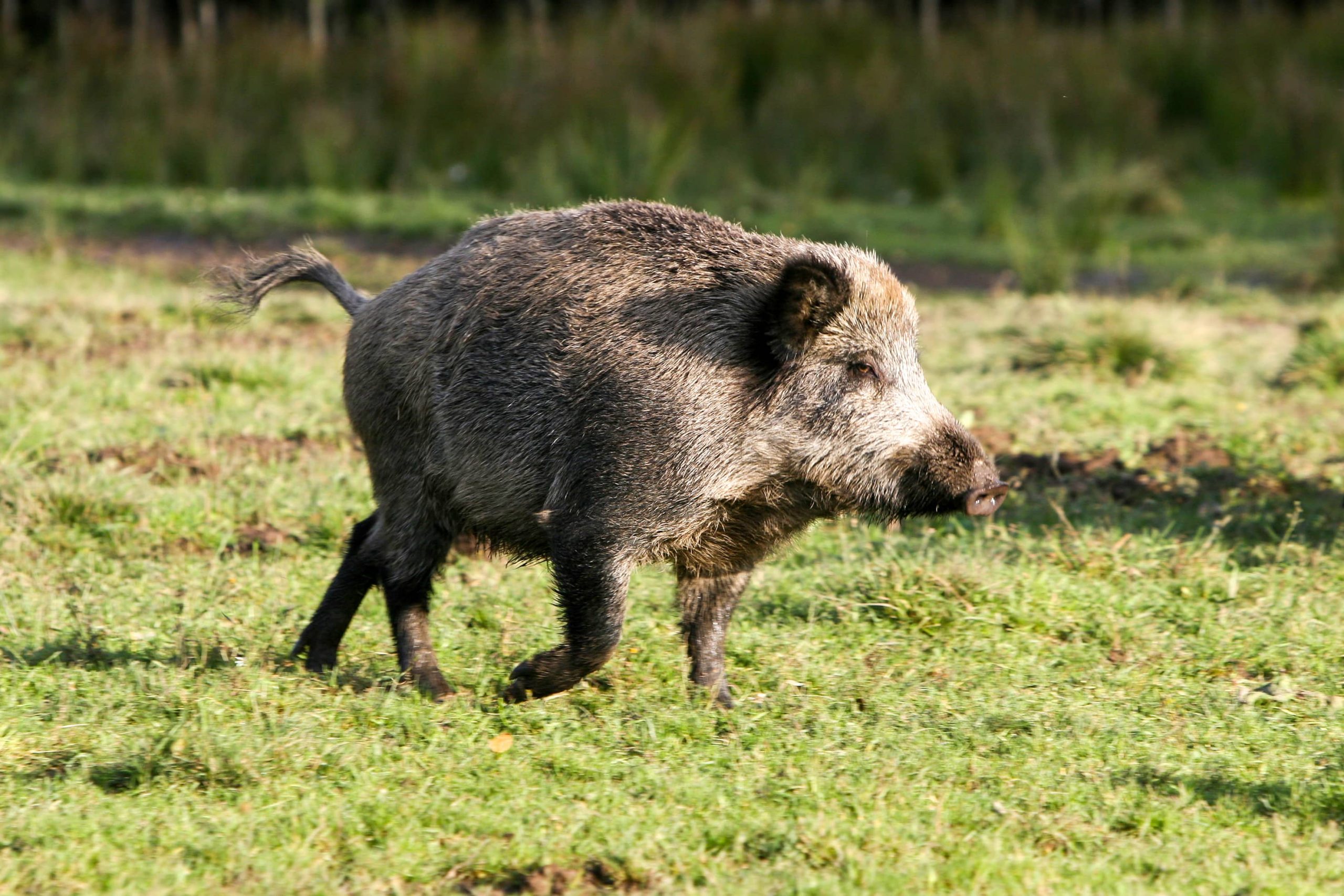
Fun fact: Despite their hefty weight, wild boars are surprisingly strong and fast runners20! They are also especially fertile, in which the females can start reproducing at 18 months19 of age and give birth to up to six piglets a year19!
In addition to spotting these animals at Pasir Ris Nature Park, do also keep your eyes peeled for the beautiful Blue Glassy Tiger butterfly21 that is also native to Singapore and identifiable by its unique bluish-grey wings. The park also features an edible garden21 with species such as lemon grass, tapioca and even the cocoa plant that is definitely worth exploring.
5. White-throated Kingfisher at Punggol Waterway Park
With a dark chocolate head, flank and belly, the White-throated Kingfisher gets its name from its contrasting whitish throat that extends down towards its breast. It’s electric blue wings and back also makes it easily identifiable from afar22. Native to Singapore22 and as one of the more common kingfishers in Southeast Asia22, it is highly adaptable and can be spotted frolicking at Punggol Waterway Park 23, alongside fringes of the reservoir as well as open fields.
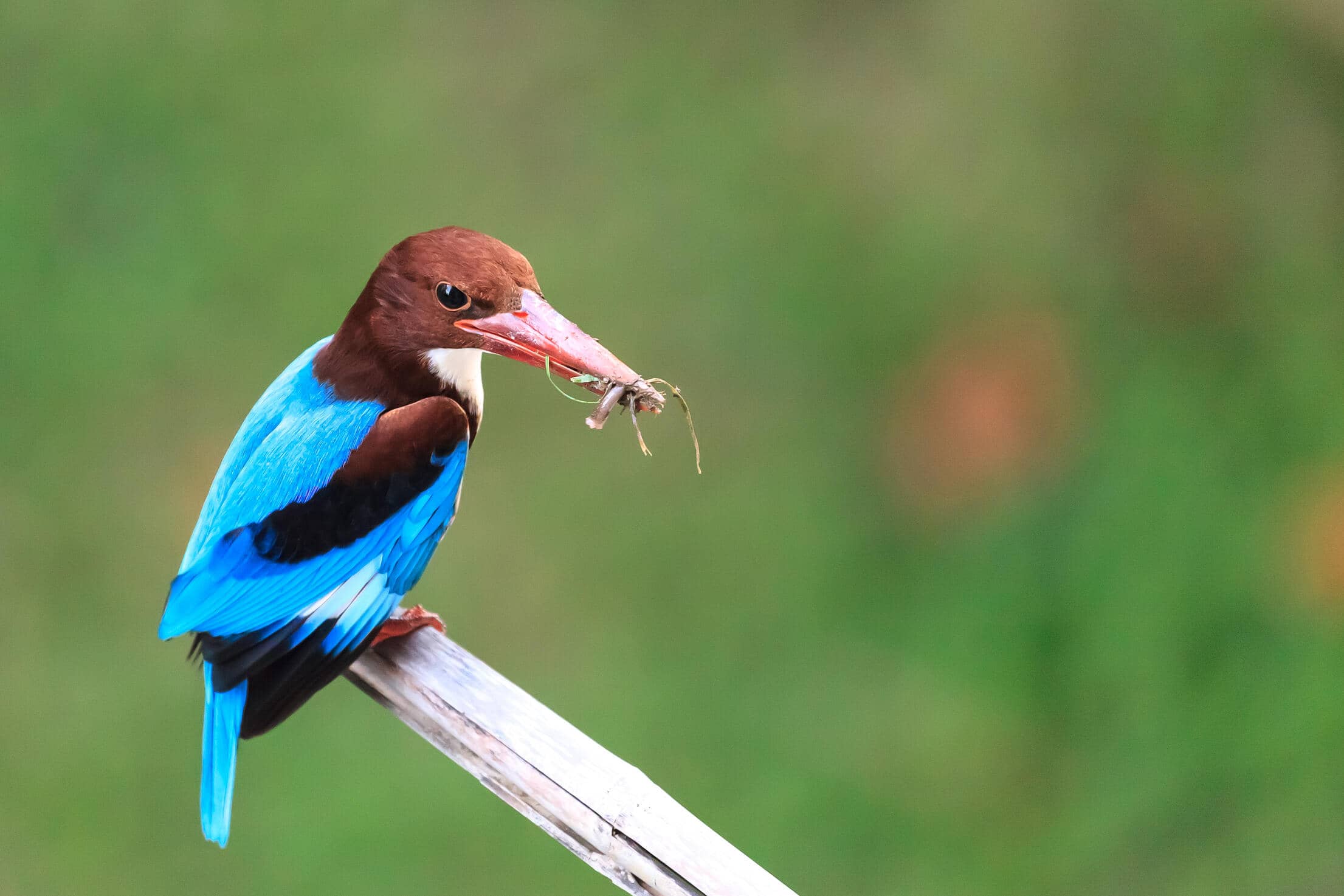
Fun fact: the White-throated Kingfisher is one of the bigger kingfisher species found locally and can grow up to 28 centimetres22. Its considerable size allows it to not only feed on insects, but also prey on fish and small animals22.
If you’re heading down to Punggol Waterway Park to spot one of these lovely birds, do also check out Singapore’s first man-made mangrove – My Waterway@Punggol24. This man-made site features a variety of freshwater-tolerant mangroves and houses many native plant species such as the Lumnitzera Iittorea24 and Kandelia candel24. Since establishing this site, it has attracted a spectrum of endangered bird species and flora, allowing them to flourish within the area and contribute to the thriving ecosystem.
We hope the above has pique your interest in heading out to discover and appreciate the whole range of wildlife we have in our country. If you’re curious to learn more about the other animals inhibiting our sunny island, check out one of Sir David Attenborough’s newest Netflix documentary here! Aptly named “Wild City”, this film unveils a whole different dimension of Singapore and takes you through the various unseen natural treasures that we might not even be aware of!
Together, let us remember the importance of a sustainable living environment, and continue to #PowerTheChange by conserving our green spaces and protect our natural heritage, so that we can share this prosperity with future generations.
Image Credits: Nylon Coffee Roasters
Source: The Sustainability Project
References:
- (2018, October). National Parks Board, Wildlife in Singapore
- (2021, October). The Straits Times, 'Crikey!': 6 recent crocodile sightings around Singapore
- (2021, February). National Parks Board, Estuarine Crocodiles
- (2022). Mandai Wildlife Reserve, Estuarine crocodile
- (2019, August). National Parks Board, Crocodylus porosus Scheneider, 1801
- (2021, August). National Parks Board, Hibiscus tiliaceus L.
- (2021, August). National Parks Board, Calophyllum inophyllum L.
- (2019). National Parks Board, Humble Natives of Sungei Buloh Wetland Reserve
- (2021, February). National Parks Board, Pangolins
- (2019, August). National Parks Board, Manis javanica Desmarest, 1822
- (2019). National Parks Board, Bukit Timah Nature Reserve: A Model for Conservation
- (2018). National Parks Board, In The Company Of Giants
- (N.D.). National Parks Board, Mammals Native to Singapore
- (2021, November). Kidadl, The Asian Palm Civet: 15 Facts You Won’t Believe!
- (2022). Mandai Wildlife Reserve, Common palm civet
- (2018). National Parks Board, Common Palm Civet
- (2016, April). National Geographic, The Disturbing Secret Behind the World’s Most Expensive Coffee
- (N.D.) National Parks Board, A Visit to Bukit Batok Nature Park
- (N.D.) National Parks Board, Wild Boars
- (N.D.) National Parks Board, What Are Wild Boars?
- (N.D.) National Parks Board, Your Guide to Pasir Ris Park
- (2019). National Parks Board, Meet the ‘Kings’ of Singapore’s Skies
- (2014, November). National Parks Board, Interesting Sights at Punggol Waterway Park
- (N.D.) National Parks Board, My WaterWay@Punggol. A Living Laboratory for Urban Living Solutions
4 Nature Reserves to Explore our Native Flora
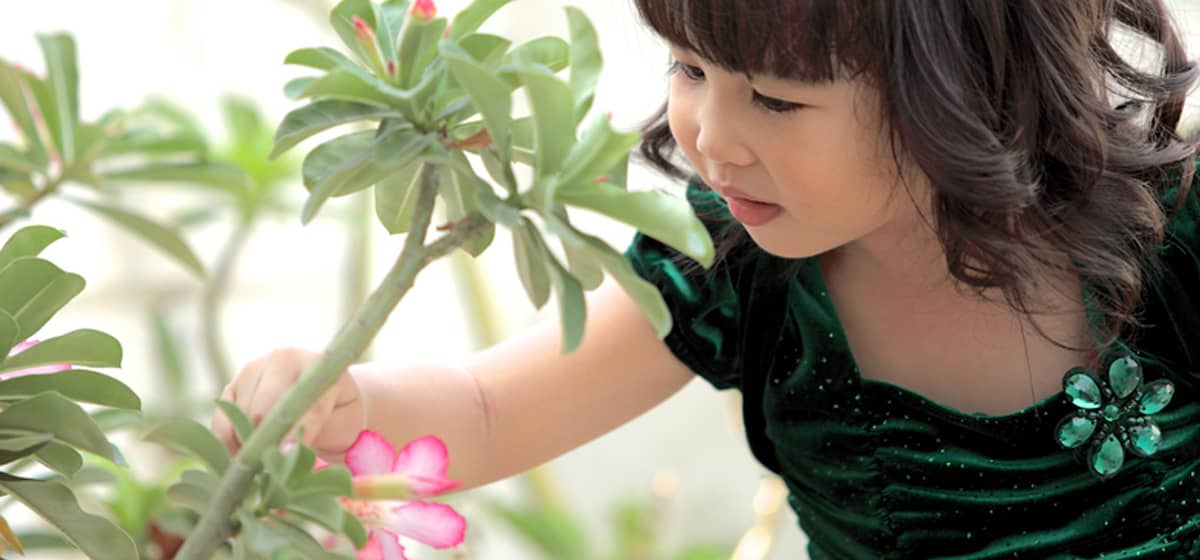
Today, Singapore is one of the greenest cities in the world, safeguarding more than 7,800 hectares of green spaces. The Garden City we enjoy today is a result of decades of hard work by our forefathers, including our then-Prime Minister Lee Kuan Yew. Known as the “Chief Gardener of Singapore”, Mr Lee introduced the “Garden City” vision in 19671, just two years after the country gained independence, with the aim to transform Singapore into a vibrant city with abundant lush greenery. This formed the core of our greening journey and the foundation in which our City in Nature2 vision, a key pillar of the Singapore Green Plan 2030, is built upon.
Over the past 50 years, more than a million1 trees have been planted across the island. Through such sustained efforts, our little red dot today boasts over 2,2003 plant species with a myriad of native flora and fauna thriving in these nature spots.
This Chinese New Year, we partnered with the National Parks Board (NParks)’s Garden City Fund to launch four exquisitely designed red packets spotlighting our native flora. With this initiative, we aim to build greater appreciation and conservation awareness among Singaporeans for our local blooms while encouraging the exploration of the abundant nature spaces in Singapore.
Each blossom featured on our red packets this year has its own unique story, and we’re excited to share more about them today while introducing a few of our other native species which you can keep an eye out for during your next hiking adventure!
1. Rose Myrtle (Rhodomyrtus tomentosa) in Coney Island Park
This beautiful magenta pink flower makes its home along the sandy beaches of Singapore’s Coney Island and thrives on the sunny weather we enjoy in Singapore. Resembling Japan’s famed cherry blossoms when in full bloom, the Rose Myrtle also produces a velvety fruit that serves as sustenance for many bird species, caterpillars, moths, and even humans!
This versatile fruit is used for a range of purposes including sweets such as jams or tarts4 and even medicines4 to treat stomach ache and diarrhoea. In Vietnam, the locals also ferment the fruit to make a type of Vietnamese wine4 known as ruou sim.
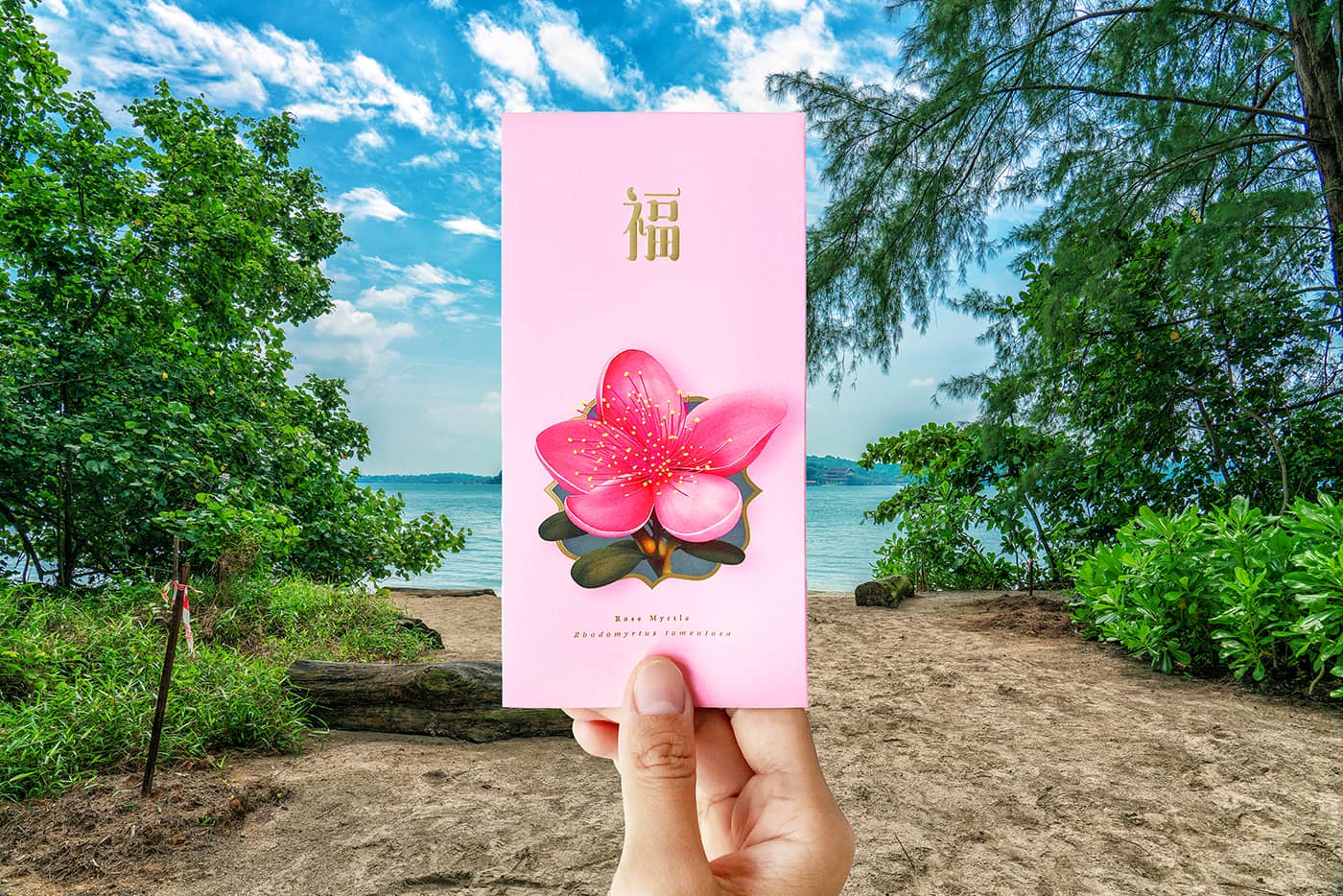
Besides the Rose Myrtle, Coney Island is also home to a variety of native flora given its recent habitat enhancement programme that aims to reforest over 50 different native coastal species5. Many of these reintroduced species are nationally critically endangered plants such as the small-leaved Nutmeg5 (Knema globularia), Silver Bush5 (Sophora tormentosa), and Damak-damak Tahun5 (Scolopia macrophylla), a tree which was presumed to be extinct until its rediscovery in 2014!
Till date, Coney Island is the only place in Singapore5 where the Damak-damak species can be found, thanks to sustained efforts to preserve our local natural heritage so do keep a look out when you head down for a day of exploration!
2. Derum (Cratoxylum maingayi) in Windsor Nature Park
A slow-growing deciduous tree that can reach a whooping height of 30 metres6, the Derum can be found at the heart of Windsor Nature Park – one of Singapore’s newer green spaces. The tree produces a faintly fragrant flora that ranges from eye-catching crimson to an interesting combination of pinkish-yellow.
While not commonly available, the Derum’s durable timber6 can be used in construction and furniture-making. Unfortunately, due to the time needed for the Derum to mature completely, the tree has been classified as a critically endangered7 species in Singapore.
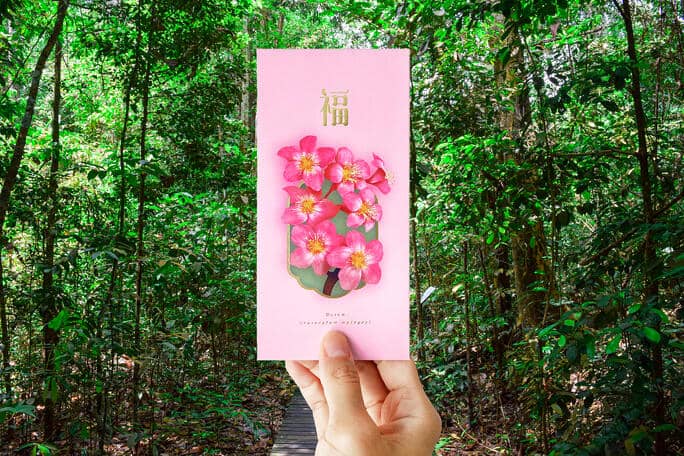
However, if you’re hoping to catch a glimpse of this rare gem during your next visit to Windsor, just look out for a pop of reddish leaves against the otherwise uniform green landscape of other trees. A conspicuous feature, the young leaves of the Derum tree are notably reddish7 before maturing into a deep forest green.
What’s more, keep your eyes peeled at Windsor’s Hanguana trail for some rare native plants that are named after Singapore such as the Zingiber singapurense8 and Durio singaporensis8. Over the years, the replanting of over 4008 trees in the park, including a myriad of native species, has helped to enhance the habitat of Windsor. This in turn has helped in attracting and protecting our local fauna including native animals such as our Sunda Pangolin (Manis javanica)8 and the Mangrove Snake (Bioga dendrophila)8, which contributes to the biodiversity of the ecosystem.
3. Akar Kekapal (Hoya diversifolia) in Pulau Ubin
Another critically endangered9 native plant, the Akar Kekapal is an epiphytic climber that often forms a dense covering on tree branches that they grow on. Resilient9 to a wide range of environmental factors, the plant can be found growing on mangrove trees in Pulau Ubin and even on oil palm in neighbouring Malaysia.
Its flowers9 often grow in umbrella clusters, forming a bouquet-like arrangement of star-shaped cream and pink blossoms that are stunning and fragrant to the senses.
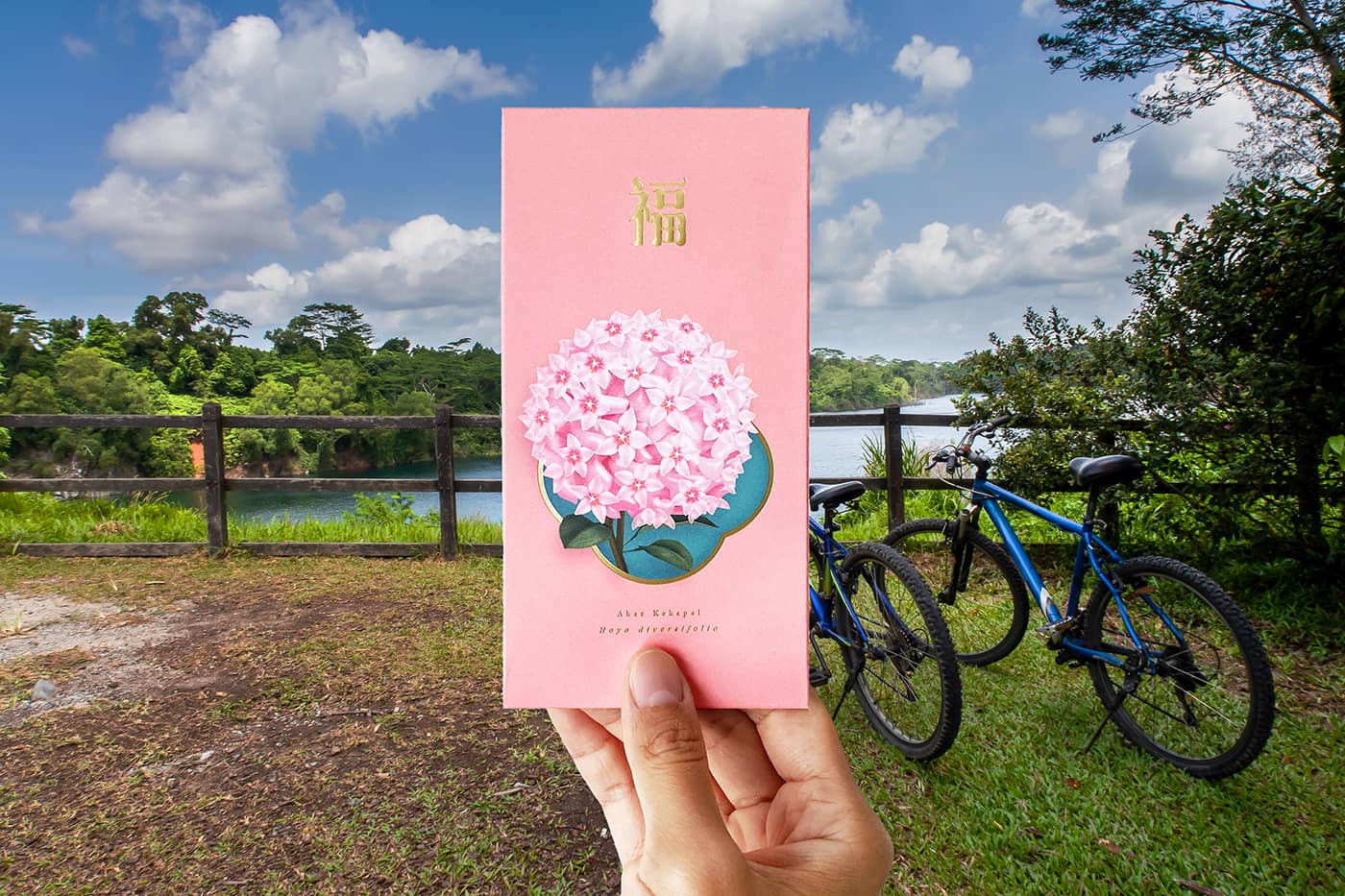
If you’re on a quest to spot as many native plant species as possible, Pulau Ubin is the right place to be! In addition to the unique Akar Kekapal flowers, keep a look out for its abundance of local plants including the Ficus stricta10, a rare species of the strangling fig, and the Jamba (Neuwiedia veratrifolia)10, a yellow orchid that is critically endangered. According to NParks, it estimates that Pulau Ubin has over 78611 native plants, with many of them very rare and not found on mainland Singapore!
As the host to the largest mangrove areas in Singapore, Pulau Ubin is also home to one of the rarest mangrove species in the world – the Eye of the Crocodile10, otherwise known by its scientific name of Bruguiera hainesii. There remains only about 200 of these plants worldwide, with 11 of them found in Singapore.
4. Wild Rose Apple (Syzygium pycnanthum) in Central Catchment Nature Reserve
Finally, the last (but not least) of our four flowers – the Wild Rose Apple an attractive and showy species with unique flora features. Similar to the Akar Kekapal, the Wild Rose Apple is tolerable12 against strong sunlight, high wind and frequent salt spray conditions; and can be found at the Central Catchment Nature Reserve and Pulau Ubin12. Both its flowers and fruits are edible and serve as food to many bird species.
The Wild Rose Apple is also classified as one of Singapore’s critically endangered12 plants, joining the list of species that NParks is on a mission to conserve.
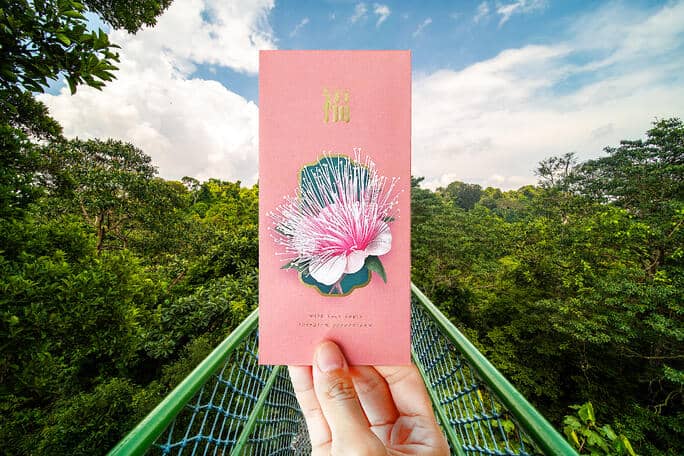
Besides the Wild Rose Apple, the Central Catchment Nature Reserve is also home to a wide range of native wildlife such as the Keruing13 (Dipterocarpus spp.), Colugo14 and the elusive Raffles’ Banded Langur15. It is believed that there are only 6015 langurs left in Singapore, limited to the Central Catchment Nature Reserve – this means that the chance of spotting one is extremely rare so do keep an eye out for it!
As the largest of nature reserves, the Central Catchment Reserve is also known as the “green lung” of Singapore and is a popular spot for nature lovers!
Fun fact: it also features the only freshwater swamp forest found in Singapore – the Nee Soon Swamp Forest16 – so do head down to check it out!
We hope that these lesser-known facts have intrigued your interest and if you’d like to win yourself these red packets, take part in our social media contest on Facebook and Instagram where you simply have to tell us your favourite local nature park and the reason why.
Two lucky winners will even walk away with a year worth of free electricity with Power Eco Add-on, Singapore’s first and only customisable green add-on for an electricity plan, plus a set of Limited Edition Geneco Red Packets! 50 lucky winners will also get to receive 2 sets of red packets and $28 eCapitaVouchers!
So what are you waiting for? Lace up your walking shoes and explore the various green spaces that Singapore has to offer.
Together, let’s continue to #PowerTheChange and conserve our natural biodiversity, and share our prosperity with our future generations as we build our City in Nature!
References:
- (2015, March). National Library Board, “Garden City” Vision Introduced
- (2021, October 8). National Parks Board, Singapore, a City in Nature.
- (2016). National Parks Board, Natural Heritage: 10 Native Plants of Singapore.
- (2021, October 14). National Parks Board, Rhodomyrtus tomentosa (Aiton) Hassk.
- (2017). National Parks Board, Working Together to Enhance the Native Coastal Habitat at Coney Island Park.
- (2021, August 6). National Parks Board, Derum.
- (2021, October 14). National Parks Board, Cratoxylum maingayi Dyer.
- (N.D.). National Parks Board, Windsor Nature Park.
- (2021, August 19). National Parks Board, Hoya diversifolia Blume.
- (N.D.). National Parks Board, Media Factsheet B.
- (N.D.). National Parks Board, A Treasure Trove of Biodiversity.
- (2021, October 14). National Parks Board, Syzygium pycnanthum Merr. & L. M. Perry.
- (2021, October 14). National Parks Board, Dipterocarpus caudatus (Foxw.) P.S.Ashton subsp. Penangianus.
- (N.D.). National Parks Board, Mammals Native to Singapore.
- (2020). National Parks Board, Introducing Our Elusive Wild Neighbours.
- (N.D.). National Parks Board, Central Catchment Nature Reserve.
Image Credits: Nylon Coffee Roasters
Source: The Sustainability Project
